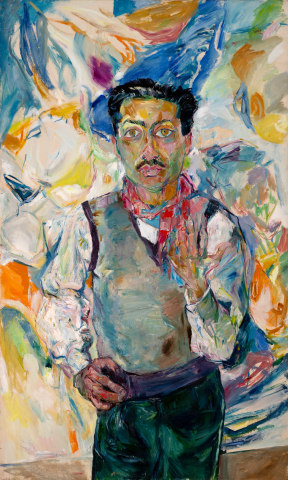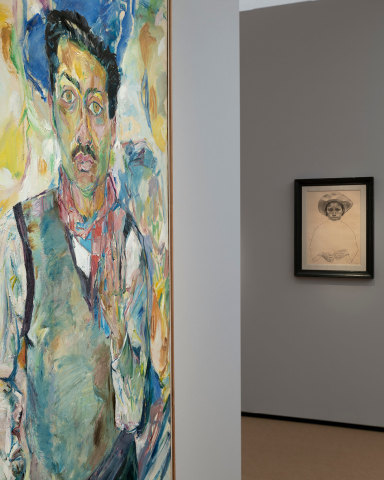Peter de Francia (British, 1921-2012)
An Indian Student (Kulwant Aurora), 1957
Oil on canvas
152 x 91 cm
12P C
Peter de Francia, an Italian-British artist and a key figure in post-war British realism, created An Indian Student (Kulwant Aurora) II, an expressive portrait that reflects his enduring commitment to...
Peter de Francia, an Italian-British artist and a key figure in post-war British realism, created An Indian Student (Kulwant Aurora) II, an expressive portrait that reflects his enduring commitment to portraying the complexities of human life. De Francia was influenced by socialist artists like Gustave Courbet, Honoré Daumier, and Renato Guttuso, whose work emphasised social justice and human suffering. He was a Professor of Painting at the Royal College of Art, London (1972–1986), and a pivotal voice in the cultural and intellectual milieu of the mid-20th century, during a period when British art was alive with political and artistic debates between realism and abstraction.
The subject of this painting, Kulwant Aurora, was an Indian student who studied painting at the Slade School of Fine Art from 1955 to 1959. After exhibiting in several prominent shows, including Young Commonwealth Artists, Aurora shifted his career toward education, becoming a respected figure in adult education and the arts, particularly within the Inner London Education Authority and the Hampstead School of Art. De Francia and Aurora were introduced to each other at the Slade, where de Francia had studied earlier (1945–1948) and continued to be engaged with the institution through the 1950s.
De Francia’s artistic background is further enriched by his time spent in Italy, where he worked in the studio of Renato Guttuso, the leading Italian socialist-realist painter, in 1947. His firsthand knowledge of postwar Italian art, coupled with his close circle of Italian artist friends, deeply influenced his style. He returned to Italy in 1949 for two years and exhibited in Milan, further solidifying his connection to the European avant-garde.
In An Indian Student (Kulwant Aurora) II, de Francia’s characteristic bold, expressionist use of colour captures Aurora’s proud and defiant stance, emphasising his individuality and presence as a young artist. Aurora is depicted confidently, hand on hip, clutching a scarf, set against a dynamic backdrop, which heightens the focus on him as a symbol of emerging talent in Britain’s post-colonial art scene. This portrait resonates with de Francia’s broader concern for representing the "everyday" in ways that provoke reflection on social and political realities. Here, the artist glorifies the arrival of new voices in the British art world, especially from post-war, multicultural backgrounds.
De Francia's broader oeuvre, including this work, often seeks to expose the contradictions in society through depictions of real or imagined subjects, blending myth and humanity. His portraits, many produced in the 1950s and 1960s, bear testimony to the intellectual cross-currents of the time, reflecting the lives and concerns of sitters who shared his sympathies for Left-wing causes. De Francia's An Indian Student (Kulwant Aurora) II is a testament to his humanistic vision, not only celebrating the individual but also commenting on the wider cultural shifts in Britain during the post-war era.
Peter de Francia held several key teaching positions throughout his career, significantly shaping British figurative art. After studying at the Slade School of Fine Art (1945–1948), he became a tutor at St. Martin’s School of Art (1953–1968), where he taught art history and complementary studies, fostering a critical engagement with social and political issues through art. He also taught at the Royal College of Art (RCA) from 1963 to 1969, before being appointed Principal of the Department of Fine Art at Goldsmiths' College (1969–1972). His most prominent role was as Professor of Painting at the RCA from 1972 to 1986, where he influenced a generation of students through his commitment to realism and politically engaged art. De Francia’s teaching emphasised the power of figurative painting to address social issues, and his mentorship inspired a host of artists, including Tony Bevan and John Monks. His focus on drawing, socialist realism, and the human condition resonated within the wider artistic community, bolstering the realist tradition in Britain during a time when abstraction dominated much of the art world. Among those impacted by this realist legacy was Paula Rego, whose narrative-driven works reflect a shared commitment to figuration and social commentary.
The subject of this painting, Kulwant Aurora, was an Indian student who studied painting at the Slade School of Fine Art from 1955 to 1959. After exhibiting in several prominent shows, including Young Commonwealth Artists, Aurora shifted his career toward education, becoming a respected figure in adult education and the arts, particularly within the Inner London Education Authority and the Hampstead School of Art. De Francia and Aurora were introduced to each other at the Slade, where de Francia had studied earlier (1945–1948) and continued to be engaged with the institution through the 1950s.
De Francia’s artistic background is further enriched by his time spent in Italy, where he worked in the studio of Renato Guttuso, the leading Italian socialist-realist painter, in 1947. His firsthand knowledge of postwar Italian art, coupled with his close circle of Italian artist friends, deeply influenced his style. He returned to Italy in 1949 for two years and exhibited in Milan, further solidifying his connection to the European avant-garde.
In An Indian Student (Kulwant Aurora) II, de Francia’s characteristic bold, expressionist use of colour captures Aurora’s proud and defiant stance, emphasising his individuality and presence as a young artist. Aurora is depicted confidently, hand on hip, clutching a scarf, set against a dynamic backdrop, which heightens the focus on him as a symbol of emerging talent in Britain’s post-colonial art scene. This portrait resonates with de Francia’s broader concern for representing the "everyday" in ways that provoke reflection on social and political realities. Here, the artist glorifies the arrival of new voices in the British art world, especially from post-war, multicultural backgrounds.
De Francia's broader oeuvre, including this work, often seeks to expose the contradictions in society through depictions of real or imagined subjects, blending myth and humanity. His portraits, many produced in the 1950s and 1960s, bear testimony to the intellectual cross-currents of the time, reflecting the lives and concerns of sitters who shared his sympathies for Left-wing causes. De Francia's An Indian Student (Kulwant Aurora) II is a testament to his humanistic vision, not only celebrating the individual but also commenting on the wider cultural shifts in Britain during the post-war era.
Peter de Francia held several key teaching positions throughout his career, significantly shaping British figurative art. After studying at the Slade School of Fine Art (1945–1948), he became a tutor at St. Martin’s School of Art (1953–1968), where he taught art history and complementary studies, fostering a critical engagement with social and political issues through art. He also taught at the Royal College of Art (RCA) from 1963 to 1969, before being appointed Principal of the Department of Fine Art at Goldsmiths' College (1969–1972). His most prominent role was as Professor of Painting at the RCA from 1972 to 1986, where he influenced a generation of students through his commitment to realism and politically engaged art. De Francia’s teaching emphasised the power of figurative painting to address social issues, and his mentorship inspired a host of artists, including Tony Bevan and John Monks. His focus on drawing, socialist realism, and the human condition resonated within the wider artistic community, bolstering the realist tradition in Britain during a time when abstraction dominated much of the art world. Among those impacted by this realist legacy was Paula Rego, whose narrative-driven works reflect a shared commitment to figuration and social commentary.
Exhibitions
La Colonna Galleria, Milan
Peter de Francia: Portraits, James Hyman Gallery, London, 28 June - 28 July 2006.
1
of 4



